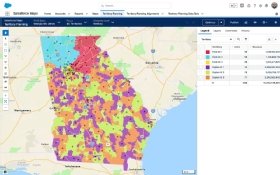
Getty Images
Salesforce expands CRM maps for sales-team territories
New patterns for selling -- salespeople travel less and use more digital channels to meet with customers -- drive new map features for Salesforce Sales Cloud.
The work of salespeople has changed in the last two years -- travel is down, digital selling is up. Salesforce added analytics and AI to Sales Cloud mapping features so users can redistribute territories in new ways.
Two of the features, Territory Planning for Digital Selling and Territory Planning for Workload Variation, are available today. Another, Territory Planning for Team Selling, is planned for next month. All three were in part built on technology acquired from MapAnything in 2019, renamed Salesforce Maps.
Territory Planning for Digital Selling supports new models of both contiguous and non-contiguous sales regions. Many Salesforce users use traditional regions that bump up against each other. But organizations whose sales operations are all-digital -- no in-person meetings -- are dividing up territories in new ways, said Derek Jamieson, Salesforce senior product manager.
Salesforce users had asked for new ways to draw up sales territories, Jamieson said. This Salesforce Maps feature enables sales team leaders to divide "digital territories" equitably when the user wasn't concerned with territories that had connected borders. When drawing up a sales map, Salesforce AI and analytics that mine a Sales Cloud user's data can take into consideration different metrics such as number and size of accounts, or revenue numbers, to spread the wealth evenly among salespeople.
"Most sales orgs still use fixed territories," said Predrag Jakovljevic, principal industry analyst for Technology Evaluation Centers. "Sales executive compensation and sales rep loyalty to a primary manager will make dynamic territories hard to implement. But if you don't have reps located in fixed territories and you sell remotely, this might work well."

Territory Planning for Workload Variation balances the regional sales map while taking into account the skill and experience of the salespeople covering the different territories. Both the features, Jamieson said, were designed to accommodate changes to sales organizations while the pandemic forced them to operationalize digital channels they may have never used before.
The Great Resignation has depleted some sales teams, Jamieson added. To deal with employee shortages, some Salesforce users have created a hybrid sales team in which reps conduct in-person meetings in areas where accounts are concentrated -- such as metro areas -- and the outlying areas are staffed by newer, digital-only reps.
Territory Planning for Team Selling applies analytics to maps to align territories for sales teams, which may include sales enablement -- and in Salesforce's case, in-house solution engineers -- as well as customer service and field technicians. Getting all the teams aligned on the same territories can be tedious work, but this automation can reduce the time it takes to accomplish.
Salesforce Maps is a team that has the attention of Salesforce co-CEO Bret Taylor, who co-created Google Maps in the 2000s. While Taylor runs the company along with founder Marc Benioff, mapping technology remains on his radar.
"We do get feedback directly from Bret Taylor," Jamieson said. "[He and Sales Cloud leadership] are always closely connected to our roadmap and our strategy."
Don Fluckinger covers enterprise content management, CRM, marketing automation, e-commerce, customer service and enabling technologies for TechTarget.






